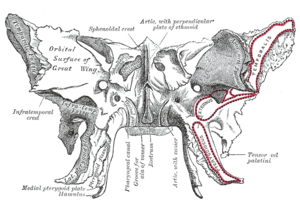Sphenoid bone
The sphenoid bone forms the center of the chondrogenic skull base. It contains many important structures that connect with other bones and together create spaces for sensory systems and muscle attachments. We also find the pituitary gland on the sphenoid bone .
Anatomical structures[edit | edit source]
The sphenoid bone is divided at the base into a corpus and three pairs of processes.
Body of the sphenoid bone[edit | edit source]
The body has the shape of an irregular cuboid (box), where the upper, lower and front walls are accessible. The posterior wall is attached to the occipital bone in synchondrosis sphenooccipitalis .
They leave the body:
- from the upper ventral part of the paired alae minores ;
- from the sides, paired alae majores ;
- from the posterior lower side of the paired processus pterygoidei .
The body of the bone is hollow, the openings are called sinus sphenoidales – paired, ventrally communicating (apertura sinus sphenoidalis) cavities in the body of the sphenoid bone. They belong to the secondary nasal cavities and are asymmetrically separated from each other by the septum sinuum sphenoidalium.
On the upper side of the body, facing the brain part of the skull, the formations are described:
- fossa hypophysialis – a pit for storing the pituitary gland , it is also referred to as the sella turcica , with the rear elevation of the dorsum sellae , by analogy with the Turkish saddle . On the dorsum sellae, paired lateral protrusions of the processus clinoidei posteriores are described, on the sides of the Turkish saddle there is an imprint of the internal carotid artery
- on the ventral side of the saddle there is a sulcus prechiasmaticus – the place where the optic nerves cross;
- canalis opticus – a wide channel from the sulcus prechiasmaticus to the eye sockets, where the optic nerve and the ophthalmic artery pass.
On the underside of the body is the rostrum sphenoidale in the middle of the surface , a sharp sagittal edge on which the vomer mounts .
Lesser wings[edit | edit source]
Small wings depart from the middle of the upper ventral side of the body in the shape of two triangles. At the center, the canalis opticus penetrates them, their upper surface is connected to the cranial cavity and the lower surface to the eye socket. The posterior border of the alae minores is considered to be the border of the anterior and middle cranial fossa. The front edge of the wings is connected by sutures to the olfactory bone and the frontal bone .
The processus clinoidei anteriores are the only visible formation here as projections from the rear edges of the wings.
Major wings[edit | edit source]
The large wings depart laterally from the body of the sphenoid bone. With its area, it participates in several places in the construction of the skull:
- facies cerebralis – the upper surface communicating with the cranial cavity, usually bears imprints of the brain's convolutions ;
- foramen rotundum – ventrally located opening leading to the pterygopalatine fossa on the maxillary surface, contains the second branch of the trigeminal nerve – n. maxillaris ;
- foramen ovale – located behind the previous opening, the third branch of the trigeminal nerve – mandibularis nerve leads to the facies infratemporalis ;
- foramen spinosum – the smallest opening dorsolaterally from the oval opening, from the facies infratemporalis it enters the skull from the bottom of the medial a. meningea together with a branch from the n. mandibularis for the dura mater cerebri;
- facies temporalis – external surface facing the temporal cavity;
- the temporal surface ends caudally with the crista infratemporalis ;
- below the crista infratemporalis begins the facies infratemporalis related to the base of the skull;
- it contains the mouth of the foramen ovale and spinosum, behind it the spine of the spina angularis (spina ossis sphenoidalis) protrudes caudally ;
- facies orbitalis – forms part of the outer wall of the orbit ;
- facies maxillaris – below the orbital part, facing the maxilla in the space of the pterygopalatine fossa.
The important fissura orbitalis superior is an elongated fissure between the posterior part of the ala minor and the anterior part of the ala major. Important nerves run here:
- n. oculomotorius;
- n. trochlear ;
- no. abducting _
- 1. branch n. triplets - n. ophthalmic;
- the superior ophthalmic vein enters the cranial cavity through this.
Processus pterygoidei[edit | edit source]
The pterygoid processes are bony lamellae extending caudally from the edge of the body of the sphenoid bone. Each pterygoid process contains two vertical laminae:
- lamina lateralis – outer wide lamella;
- lamina medialis – inner narrow lamella;
- hamulus pterygoideus – externally curved hook at the end of the inner lamella, the tendon of the tensor veli palatini muscle wraps around it;
- canalis pterygoideus (Vidii) – a channel running from back to front at the distance of the processus pterygoideus, leads here n. et a. canalis pterygoidei.
The most common variations[edit | edit source]
Articulated bone has many variations, the most common being incomplete ossification of the foramen ovale, accessory openings around the oval opening, bony bridges from the spina ossis sphenoidalis to the lateral lamina of the pterygoid process, a developed canalis craniopharyngeus in the body of the sphenoid bone or a bony bridge between the proc. clinoidea.
Links[edit | edit source]
Related articles[edit | edit source]
References[edit | edit source]
- ČIHÁK, Radomír – GRIM, Miloš. Anatomie. 2. upr. a dopl edition. Praha : Grada Publishing, 2001. 497 pp. vol. 1. ISBN 80-7169-970-5.




